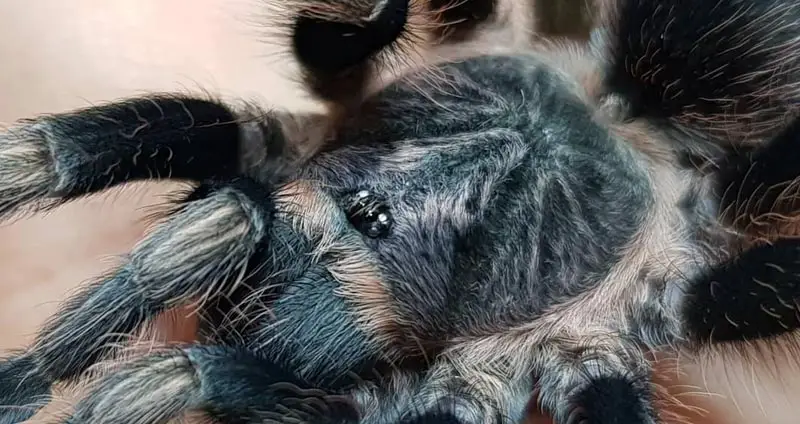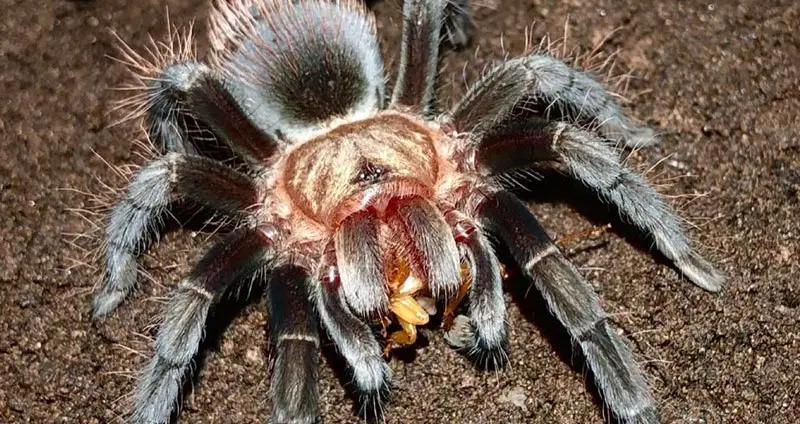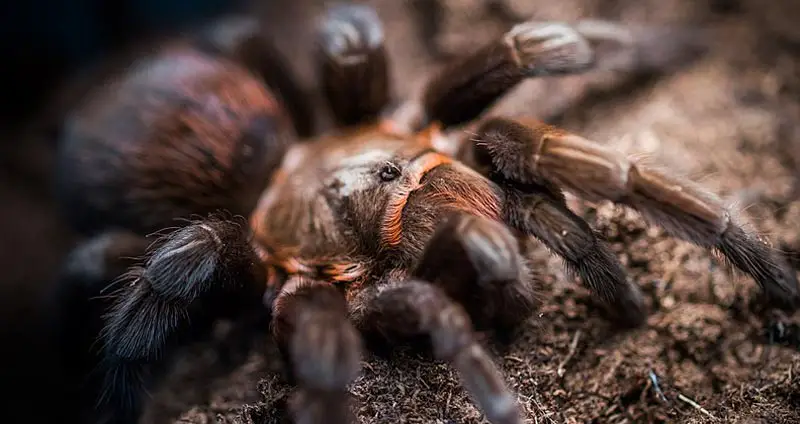With hundreds of different tarantula species existing in the world, some have become incredibly popular, and some are a lot lesser-known. Brachypelma kahlenbergi, or the New Mexican tarantula, is one of those “under-the-radar” tarantulas.
This care sheet will provide you with everything that you need to know about this wonderful tarantula species, including its diet, housing requirements, and temperament.
Table of Contents
Brachypelma kahlenbergi Care Sheet
Common Name |
New Mexican |
Species Type |
New world terrestrial |
Habitat |
Found in moist forests of Veracruz, Mexico. |
Growth Rate |
Medium growth rate, growing about an inch per year. |
Adult Size |
Females reach a legspan of about 5″, with males measuring slightly smaller. |
Lifespan |
Estimated to be about 20 years for females and 5 years for males. |
Enclosure |
The enclosure should be wider than it is tall with an emphasis on floor space. 6 inches of substrate should line the floor of the enclosure, and a hide and water dish need to be present. |
Temp/Humidity |
76°F to 82°F with about 75% to 85% humidity. |
Diet |
An excellent eater that attacks prey with a vengeance. Can eat several adult crickets per week. |
Temperament |
A very docile and friendly tarantula. Almost never flicks hairs or throws up threat poses, although they will if they need to. |
Experience Level |
Beginner – Very easy to care for temperament-wise, and their care requirements are very basic. |
Average Cost |
Slings ~ $45, Males ~ $100, Females ~ $150+ |
Brachypelma kahlenbergi Appearance
Although some tarantula species in the Brachypelma genus are rather exotic with brilliantly colored legs, B. kahlenbergi tends to be dark-colored with an orange-brown hue covering their abdomen.
Don’t confuse the Brachypelma kahlenbergi tarantula with the B. vagans or commonly known as the Mexican Red Rump. They’re strikingly alike in appearance that people often mix them up.
The New Mexican tarantula is also considerably smaller in size than the rest of the species in the genus. With a size reaching up to about 5 inches, females of the Brachypelma kahlenbergi species, for the most part, are larger than the males. Their legs, however, are shorter compared to the opposite sex.
There isn’t too much information available regarding lifespan of this species. It’s speculated that females can live up to 20 years, while males only live up to 5. Due to this longer lifespan, spiderlings grow at an average pace.

Brachypelma kahlenbergi Temperament
First established by arachnologist Eugène Simon, the Brachypelma genus has quite the reputation in the pet world for being easy to look after.
Brachypelma kahlenbergi tarantulas are docile and are often referred to as ‘pet rocks’. They make an exceptionally good choice for inexperienced keepers to keep, and it’s quite easy to handle them.
They also make for ideal display tarantulas due to the fact that they spend a lot of time above ground outside of their burrows.
They’re new world tarantulas that are generally known for their calm nature and preference to run from danger as opposed to fighting it. Thus, you’ll rarely see this species throwing up threat poses or flicking hairs — although this can still happen.
Overall, though, this is a great tarantula species for beginners. It isn’t fossorial so it’s frequently on display, and it tends to be very calm most of the time. This isn’t unlike most other members of the Brachypelma genus, though.
Housing Brachypelma kahlenbergi
Sharing a house with New Mexican tarantulas won’t be a hassle as long as you provide them with a fitting enclosure.
They don’t have many specific needs, meaning that it’s quite simple to provide them with a good home.
Optimal Enclosure
Taking the fact that Brachypelma kahlenbergi spiders are burrowing tarantulas into consideration, having a terrestrial enclosure for them would be the best option.
Terrestrial enclosures mainly focus on providing floor space and hiding spots since your tarantula would be spending its time on the ground.
A good terrestrial enclosure should be secure, should give your tarantula enough space to move around and has a good air-flow for ventilation.
The Exo Terra 18″ × 18″ × 12″ terrarium would be a suitable enclosure for your Brachypelma kahlenbergi tarantula, as would the Repti Zoo 20″ x 12″ x 10″ enclosure. Both of these provide ample floor space to roam around and enough depth to create burrows.
Enclosure Decorations
You’d want to keep the inside of the enclosure resembling a forest floor as much as possible for your ground-dwelling New Mexican tarantula. To be able to do so, you’ll need a couple of tarantula decorating supplies.
Decorating the inside of your tarantula’s terrestrial cage includes layering about 6 inches of moisture-retaining substrate on the ground. This allows for burrowing, humidity-retention, and overall cleanliness of the enclosure.
A tarantula hide should also be present to allow for Brachypelma kahlenbergi to hide in and feel more secure with. Cork bark or coconut shells are among the most popular choices for hides.
The presence of a clean water source is important for your New Mexican spider as well. In case you didn’t know, tarantulas drink water to stay hydrated. Keeping a fresh water bowl inside your tarantula’s enclosure is necessary to prevent dehydration and to keep humidity levels consistent.

Enclosure Temperature/Humidity
The natural habitat of the Brachypelma kahlenbergi tarantulas lies in Mexico, where the moist forests of Veracruz experience rain annually more than the Pacific coast does.
As a result, the New Mexican spiders are accustomed to temperatures ranging from 69°F to 85°F, with an average humidity of 85%.
In terms of temperature, this is right around room temperature for most people. However, if your home is consistently very cool, you may need to provide supplemental heating through a space heater.
For humidity, this is quite high. You can keep the enclosure humid by misting the substrate every other day and overfilling the water dish so that the substrate around it becomes moist.
Monitor the environmental conditions constantly using a thermometer/hygrometer and make adjustments as needed. Remember, enclosures that are too hot or humid are just as bad as enclosures that aren’t hot or humid enough!
Diet
Nutrition is vital for the growth of your Brachypelma kahlenbergi. Since spiderlings are fragile and prone to the danger of being injured by larger prey, you need to take that fragility into account.
Slings less than 1/2″ in leg span mostly eat small insects such as flightless fruit flies.
As your tarantulas grow out of their sling phase, they can start to eat different foods. Pinhead crickets are great for larger slings, and adults can eat normal-sized crickets or dubia roaches.
Feeding frequency averages about several times per week, but every tarantula is different. Adjust your B. kahlenbergi‘s feeding schedule as needed.
Health Concerns
Tarantulas in captivity don’t frequently experience issues regarding their health. However, there are some problems your tarantula might find itself facing.
Mite infestations are quite rare with tarantulas, but they do occur. While they aren’t immediately dangerous, you’ll want to avoid them at all costs. Fortunately, it’s quite easy to avoid them or get rid of them if an infestation arises.
Tarantulas may also face dehydration if their enclosure isn’t humid enough or they don’t have access to a water source. That can be solved by providing your tarantula with a water bowl as we previously mentioned. Adjusting the temperature of the enclosure can help fight dehydration too.
Moreover, there’s another issue you should keep an eye on. Though the aforementioned problems affect your tarantula’s health, they aren’t as fatal as a ruptured abdomen.
A tarantula can rupture its abdomen when it falls from even short distances. Tarantulas with ruptured abdomens don’t have great survival rates, so you’ll want to avoid this at all costs. Keep their enclosure secure, and keep handling to an absolute minimum.
Brachypelma kahlenbergi For Sale & Price
Tarantulas vary in their price according to the type and availability of the species.
The Brachypelma kahlenbergi species is fairly sought-after due to their colorful appearance and agreeable personality. Because of the increase in agricultural activity and several additional causes, some of the Brachypelma species have become endangered.
The B. kahlenbergi tarantula is affordable compared to other species of tarantulas. For instance, a B. kahlenbergi sling can cost around $45. An adult female, on the other hand, tends to cost around $150 to $200. Don’t be surprised if you found them at a higher price since they’re not very common.
The Brachypelma kahlenbergi tarantulas’ beautiful appearance combined with their calm personality is definitely worth purchasing or adding them to your tarantula collection.

